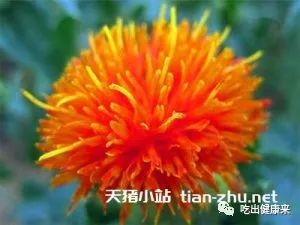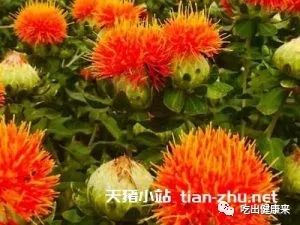The Benefits and Effects of Safflower: What Are the Pros and Cons of Drinking Safflower Tea?
Safflower, also known as Honghua (红花), is referred to as red-blue flower, prickly safflower, and grass safflower. It has the effects of promoting blood circulation, regulating menstruation, and alleviating pain.
Drinking safflower tea regularly can help regulate coronary heart disease, especially in cases of blood stasis, and can also alleviate shoulder and back pain, as well as pain in the legs and lower back.
Safflower is often combined with other herbs to treat minor injuries. It can be taken orally or applied externally. For external use, safflower can be boiled in water and used to wash the affected area, helping to dispel blood stasis and relieve joint pain, showing significant efficacy.
Next, let’s discuss the benefits and effects of safflower, the pros and cons of drinking safflower tea, and whether it is advisable to soak feet in safflower water daily.

Recommended Reading: The Benefits and Effects of Purple Cabbage: How to Avoid Purple Cabbage Poisoning?
The Benefits and Effects of Safflower:
1. Anti-inflammatory and Pain-relieving
Safflower contains anti-inflammatory active ingredients that can effectively suppress inflammation in the body and have a good regulatory effect on the pain associated with bedsores. The main preparation method is: 500g of safflower is added to 7000ml of water, boiled for about 2 hours until the safflower turns white, then strain the solution and simmer on low heat for 3-4 hours until it becomes gelatinous. Apply this mixture on gauze and place it on the affected area, securing it in place, and change the dressing every other day. Generally, noticeable effects can be seen after one or two applications.
2. Calming and Sedative
This is mainly due to the presence of safflower yellow pigment, which has good regulatory effects on ischemia, hypoxia, and intercostal muscle hypoxia. Experiments have shown that safflower can enhance the efficacy of pentobarbital sodium and chloral hydrate, thus achieving a calming and blood-nourishing effect. Those who work long hours and are mentally stressed or fatigued may benefit from drinking safflower tea to help stabilize their mood.
3. Beauty and Spot Removal
Safflower contains substances that can regulate endocrine functions, dissolve existing melanin, and effectively improve various spots, pigmentation, and acne.
4. Cardiovascular Protection
Safflower also provides certain support for cardiovascular diseases, as it can prolong the coagulation time of thrombin in the blood, improving the condition of thrombosis. It helps in blood coagulation and the renewal of thrombus. Safflower can delay the coagulation time of prothrombin and thrombin in the blood, which can improve the condition of thrombosis and has many benefits for cardiovascular diseases.
5. Promoting Blood Circulation and Unblocking Meridians
The most important effect of safflower is promoting blood circulation. It can be used to address issues such as amenorrhea, dysmenorrhea, postpartum blood stasis, abdominal pain due to blood stasis, bruises, varicose veins, and purpura.
Differences Between Safflower and Saffron
Safflower and saffron are two different plants. Safflower belongs to the Asteraceae family, while saffron is a member of the Iridaceae family. From a TCM perspective, both have the effects of promoting blood circulation, regulating menstruation, and alleviating pain, and can be used for injuries, abdominal pain due to blood stasis, ulcers, postpartum blood stasis, liver qi stagnation, qi stagnation and blood stasis, and menstrual irregularities. However, there are certain distinctions in terms of origin, composition, and appearance.
1. Origin: Saffron is originally from Mediterranean countries, while safflower is mainly cultivated in cold regions of China, including Beijing and Shanghai. Safflower is grown worldwide, making saffron rarer than safflower.
2. Composition: The components of safflower and saffron are quite different. Safflower contains safflower glycosides, safflower polysaccharides, safflower yellow pigment, lauric acid, cinnamic acid, and various organic acids. Saffron contains saffron bitter glycosides, lauric acid, saffron aldehyde, dimethyl saffron acid, and various vitamins and thiamine compounds.
3. Appearance: Safflower is lighter and softer, with a faint fragrance and a slightly bitter taste. It has tubular flowers without ovaries, appearing yellowish-red or bright red, with thin and long flower stalks, about 1-2cm in length. Saffron, on the other hand, is dark red, aromatic, elongated in shape, and does not leave sediment when soaked in water. The style can be seen sinking in the water, showing a yellow line that widens from thin to thick, and the stigma can appear trumpet-shaped in water, dyeing the water yellow.
Can You Soak Your Feet in Safflower Water Every Day?
Soaking feet in safflower water can significantly improve blood circulation, promote blood flow, and dispel blood stasis, helping to alleviate cold pain in the lower limbs caused by blood stasis. It can also reduce symptoms of varicose veins and improve blood flow in the lower limbs. Many people can alleviate varicose vein symptoms without surgery. Additionally, it can help relieve numbness in the limbs. Combining safflower with salt water and moxibustion can alleviate numbness symptoms, generally improving within a few days. Many patients recovering from serious illnesses may have residual blood stasis in their bodies; soaking feet in safflower water with vinegar can help dissolve this residual blood stasis and accelerate postoperative recovery.

Recommended Reading: The Benefits and Effects of Taro: Can You Still Eat Sprouted Taro?
What Are the Pros and Cons of Drinking Safflower Tea?
Safflower tea has the effects of promoting blood circulation, regulating menstruation, and alleviating pain. However, long-term or excessive consumption may lead to some discomfort, such as dizziness, diarrhea, abdominal pain, excessive excitement, and restlessness. Additionally, it may cause internal bleeding disorders; for example, long-term consumption by women may lead to menstrual irregularities, increased menstrual flow, and delayed periods.
It is important to note that pregnant women should not drink safflower tea, as it can stimulate uterine contractions and increase the risk of miscarriage. Women during menstruation should also avoid drinking safflower tea, as it can increase menstrual flow. Patients with bleeding disorders, such as purpura or gastric ulcer bleeding, should also avoid drinking it, as it may exacerbate bleeding symptoms.
Safflower tea should not be consumed daily, as it is a traditional Chinese medicine. Especially during menstruation, it should not be consumed due to its blood-promoting effects, which can lead to menstrual irregularities, excessive bleeding, and prolonged periods. It is advisable to resume drinking only after menstruation has ended. Safflower is a traditional Chinese medicine that can help alleviate pain, regulate menstruation, and has beneficial effects on cardiovascular diseases, dysmenorrhea, and amenorrhea. It can also lower blood pressure, reduce blood lipids, regulate endocrine functions, and protect the liver, significantly increasing coronary blood flow.
For more content, please click to read the original article or search for Tian Zhu Xiao Zhan on Baidu.
If you find this useful, please like and support us.
Follow me for more health tips!

